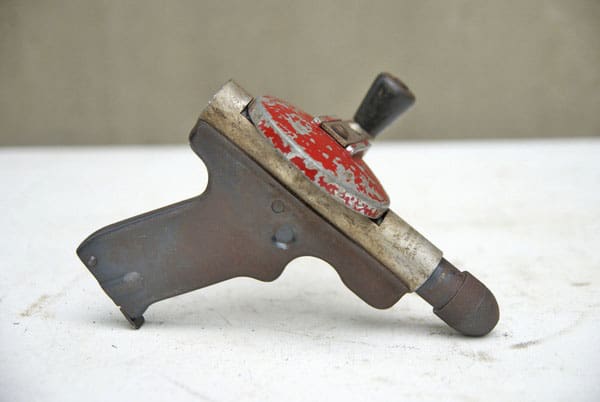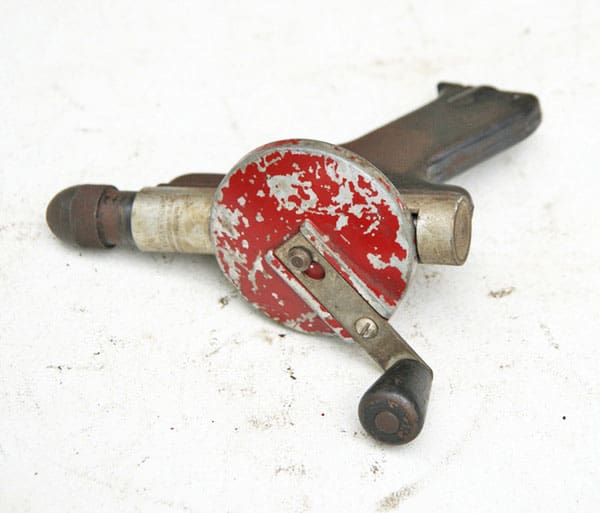 When you think of Ruger, you immediately think of drills and other hardware tools you would find in your toolbox, right? No? Well, that could have been the path Ruger had taken if things had gone differently after World War II. In 1946, Bill Ruger formed The Ruger Corporation in Southport, Connecticut. His goal was to supply parts to the firearm industry and eventually create his own pistol. One other key component of his business model involved developing a line of tools. You know – drills, screwdrivers, wrenches, etc. Within only a few years’ time, Bill Ruger was in a tough spot. Things weren’t going well and his company was in a bit of a tailspin that eventually led to bankruptcy. By 1949, The Ruger Corporation ceased to exist altogether. Despite this, Ruger learned some valuable business lessons in his failed venture. He learned what worked and what didn’t and also laid the groundwork for some of his pistol designs. That first business had to fail in order for Bill Ruger to team up with Alexander Sturm. If it hadn’t happened, we wouldn’t have Sturm, Ruger & Company today.
When you think of Ruger, you immediately think of drills and other hardware tools you would find in your toolbox, right? No? Well, that could have been the path Ruger had taken if things had gone differently after World War II. In 1946, Bill Ruger formed The Ruger Corporation in Southport, Connecticut. His goal was to supply parts to the firearm industry and eventually create his own pistol. One other key component of his business model involved developing a line of tools. You know – drills, screwdrivers, wrenches, etc. Within only a few years’ time, Bill Ruger was in a tough spot. Things weren’t going well and his company was in a bit of a tailspin that eventually led to bankruptcy. By 1949, The Ruger Corporation ceased to exist altogether. Despite this, Ruger learned some valuable business lessons in his failed venture. He learned what worked and what didn’t and also laid the groundwork for some of his pistol designs. That first business had to fail in order for Bill Ruger to team up with Alexander Sturm. If it hadn’t happened, we wouldn’t have Sturm, Ruger & Company today.  One of the only tangible items that remain from The Ruger Corporation are hand drills. In an era of simplicity, Ruger’s hand drill fit right in. Ergonomically designed to fit in your hand and basic in terms of operation, the crank on the top powered the bit. Originally, the hand crank portion of the drill was red – a color still associated with Ruger today. Looking at it, you can easily see the foreshadowing in design of what would become the Ruger Mark series of pistols. Cover up the top portion of the drill mechanism and the basic form of the pistol is definitely there. You’d almost swear you could put an upper receiver on it and have a functioning pistol if it weren’t for the lack of a trigger. With Ruger’s new business venture firmly rooted in firearms, drills and other tools became a thing of the past. As such, they’re a rarity today and are highly prized by serious Ruger collectors. Obviously, condition is everything when it comes to collectability. The better the condition and the more red paint still left on the drill, the higher the price will go. Generally, they sell for a couple hundred dollars when you can find one. If Ruger had initially been able to sell his hand drills for that kind of money, he wouldn’t have gone bankrupt. But then again, I think I’d rather have Ruger firearms than Ruger screwdrivers.
One of the only tangible items that remain from The Ruger Corporation are hand drills. In an era of simplicity, Ruger’s hand drill fit right in. Ergonomically designed to fit in your hand and basic in terms of operation, the crank on the top powered the bit. Originally, the hand crank portion of the drill was red – a color still associated with Ruger today. Looking at it, you can easily see the foreshadowing in design of what would become the Ruger Mark series of pistols. Cover up the top portion of the drill mechanism and the basic form of the pistol is definitely there. You’d almost swear you could put an upper receiver on it and have a functioning pistol if it weren’t for the lack of a trigger. With Ruger’s new business venture firmly rooted in firearms, drills and other tools became a thing of the past. As such, they’re a rarity today and are highly prized by serious Ruger collectors. Obviously, condition is everything when it comes to collectability. The better the condition and the more red paint still left on the drill, the higher the price will go. Generally, they sell for a couple hundred dollars when you can find one. If Ruger had initially been able to sell his hand drills for that kind of money, he wouldn’t have gone bankrupt. But then again, I think I’d rather have Ruger firearms than Ruger screwdrivers.
Logan Metesh is a firearms historian and consultant who runs High Caliber History LLC. Click here for a free 3-page download with tips about caring for your antique and collectible firearms.



Little known feature is the crank pops up when a bit is loaded.
Also the drill won’t turn without a bit loaded.
And you can only crank it ten revolutions before reloading the bit. No one needs more than that.
Okay, I’m done.
The 10 rev part’s gonna be lost on the young ‘uns.
O2
Can you mount a shoulder brace (to steady your drilling, or if you are labeled “disabled”). Can you touch that brace to your shoulder?
If it has that brace, can you use a drill bit less than 16″”
Does it come in .40 S&W?
Ok, I’m done.
Ruger: making holes in things since 1946!
Okay, I’m done.
As one who has used a lot of old manual drills, I’m struck by how the ergonomics are parallel to the Mark pistols. That set-up would be bad for heavy-duty drilling, but for light work would be great, just as the Mark pistols are great for their light caliber but not much for heavy-duty jobs (such as, for instance, stopping bears).
BTW, the similarity of the grip to the Mark pistols provides an interesting view on the old phrase “I’m gonna drill you!”
Plus, without modification, the drill chuck does not stay spread open when the drill is removed. : (
Ok, I promise, I am trying to be done.
UBC required to buy. NJ would pass that law.
There was a Ruger hand drill that sat next to the new Rugers in the LGS i used to go to back in Wyoming. In way nicer shape than the one pictured. Neat piece of history
Are you saying that if you buy a Ruger, you’ll likely get screwed?
Where I come from, dem are fighting words!
If you look back at the history of Winchester, you see that they had a foray into consumer goods as well.
Red Ruger, Red Ruger, make mine in Nine Luger
“Looking at it, you can easily see the foreshadowing in design of what would become the Ruger Mark series of pistols.”
Oh, great.
So, it’s nearly impossible to break down and clean, then?
Not until the fourth generation.
That’s a P model I believe. P1/2.
Built like a tank.
Gets the job done.
Handle rotation is a little gritty, but a quick break in and it gets better…
After the huge success of the Ruger Standard Pistol, Bill paid every one of his creditors back that were shorted because of the tool business bankruptcy–how many of us would have done that?–truly an honorable person that founded a very honorable firearms company
To add into the history bit, one company that made 1911’s during WWII was Remington Rand. Ironically, not only do they have a limited connection to the firearms company, but they went the other way. In 1886, Remington sold their typewriter segment. This segment was eventually bought and merged with Rand Kandex Bureau, to form Remington Rand. RR built the Univac and was the originator of the Remington electric razor.
Just picked up a ruger drill…can’t wait to compare it to my Mark 1 standard pistol.
Comments are closed.